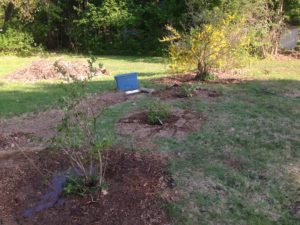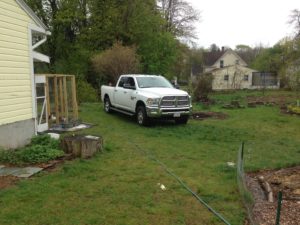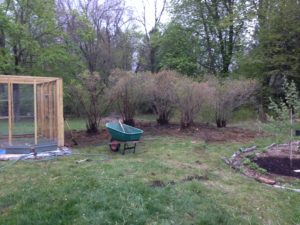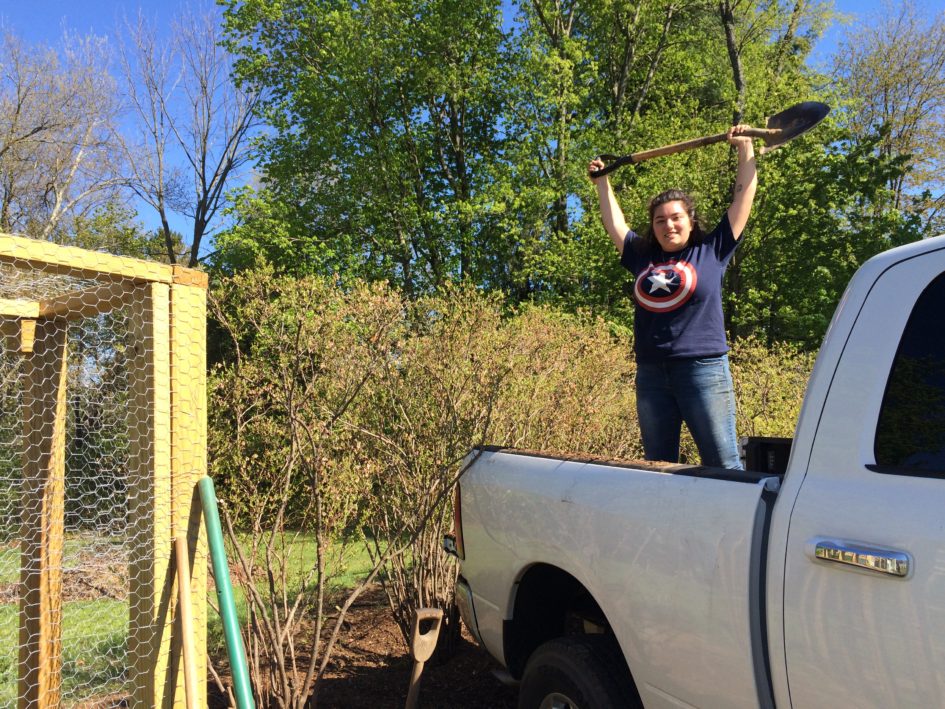If you’ve been following us you might know we had four blueberry bushes planted behind our brand new Chicken Coop (you might have read about them in Our Harvest Report or Granola with fresh berries). Two of which we acquired from our friends at Green Acres Farm Mother’s Day Weekend 2015. We lovingly refer to the group as Grams, Gramps and the Grandkids. Gram and Gramps are 60+ years old and the two blueberries in between (or the grandkids) are about two to three years old, we’ve had them for a little over a year.

Grams, the Grandkids and Gramps
It was several weeks ago that Becky at Green Acres Farm said she and her husband Dan were putting in a new small pasture for her horses. She told me that they would be getting rid of over 50 blueberry bushes and asked would you like them?
Rule Number One of Permaculture: Never say no to free healthy plants!
So of course we said yes. Free plants are the best plants. It does depend on what it is, if it’s invasive make sure to plant is properly. If it’s ugly, plant it out of sight. If it’s dead and the giver doesn’t realize, still take it and thank them like it was alive. You never want to give them the idea that you wont take free plants. I got my start as plant hospice, people would give me plants even though I would slowly welcome them into death. So how did we do it?
Transplanting
The day we did the blueberry transplants was a perfect day, very overcast and not too hot. It happened by chance, but if you can always plan to move plants when it is not sunny out. The sun will wilt the plants quickly and drain the water out of the root mass.
The loading of the truck was surely the most “difficult” part but was the quickest since Dan used a tractor to pull the bushes out of the ground. Without the bucket loader, the loading would not have gone too well. We were able to fit 2 bushes into the back.
Once we got back to the house to unload the first batch, the fun began. We had dug large holes to take the new bushes, we only had 1 problem. We could not move the bushes off the truck. We tried everything, including tying the bush to a nearby tree and trying to drive the truck out from under. To no avail. The rope snapped before the bush even moved. Luckily we called in Dan, who was able to use his 10x combined strength to get the bushes off the truck. He had to remove substantial parts of the root systems to make them movable still. 3 trips and 8 hours later we had 6 new bushes in the ground in the back.
Establishment
We then passed out for 2 straight days, although the work was not complete. We got back out there within a couple days to complete the preparation. First we leveled the areas around the bushes and took care to make sure the root balls were in place and secured. We then picked up two 50′ soaker hoses and laid them around the bushes. One thing we learned quickly, soaker hoses do not work with ANY kind of incline, they must always run downhill. It took us a good 20 minutes to get the hoses where they needed to be. Initially we had 2 soaker hoses on a splitter. We realized this puts too much of the flow at the beginning of the hoses and not enough at the end. So we actually used a little trickery. We hooked 1 soaker hose right off the splitter, and the second soaker hoses was connected to a straight hose and started from the other end of the bushes.

Here’s the finished product, our blueberry hill
Once the watering setup, we picked up 2 yards of mulch from the nearby mulch yard and spread it out. This will help retain moisture in the root systems and help establishment. What’s amazing is the number of bees that have shown up around the bushes. There are hundreds of buds, and the bees go crazy. I’ve counted as many at 15 bees at one time around the bushes. For the first couple months we will keep the bushes well watered. Since we lost so much of the old roots, if we don’t keep them watered the bushes will start to wilt because they’re not pulling up the amount of water they need.
Watering Tip: One thing I heard is that you should actually water when it rains rather than when it’s dry. If you water when it rains, you encourage deeper root growth toward the water. After a while this will deepen the roots and allow for the plants to sustain themselves through dry spells. If you only shallow water every few days there will be no need for the plant to develop deep roots and you will be stuck having to water.
Share Now!


